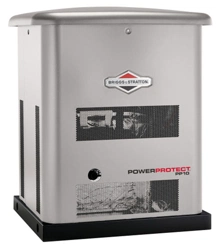Loading ...
Loading ...
Loading ...

16
Lifting the Generator
The generator weighs more than 330 pounds (150 kg).
Proper tools, equipment and qualified personnel should be
used in all phases of handling and moving the generator.
Two 60” lengths of 3/4” nominal minimum scheduled 40
steel pipe (A), supplied by the installer, are required to
lift the generator manually. Insert pipes through the lifting
holes (B) located near the unit’s base.
You may also lift the unit using a “hook and hoist” method
attached to the lifting pipes, provided that you use a
spreader bar to ensure that the chains or cables DO NOT
touch the generator’s roof.
WARNING Hazardous Voltage - Contact with power lines
could cause electric shock or burn, resulting in
death or serious injury.
Lifting Hazard / Heavy Object - Could result in
serious injury.
• If lifting or hoisting equipment is used, DO NOT contact any
power lines.
• DO NOT lift or move generator without assistance.
• Use lifting pipes as described in Lifting the Generator.
• DO NOT lift unit by roof as damage to generator will occur.
In areas determined to be hurricane prone, it is
recommended to anchor the standby generator to concrete.
The concrete slab should be at least 3” (76mm) thick and
6” (152mm) longer and wider than the unit [32” (813mm) x
29” (737mm)]. Use 1/4” (6mm) diameter (minimum) by 3”
(76mm) long (minimum) masonry anchor bolts to retain the
unit. There are three 7/16” hole locations (C) in the base of
the generator in which to anchor the unit.
Concrete Anchoring of Unit
C
C
C
NOTICE Unless mandated by local or state code, a
concrete slab is not required.
B
A
22.559” (573mm)
19.016” (483mm)
Not for
Reproduction
Loading ...
Loading ...
Loading ...
